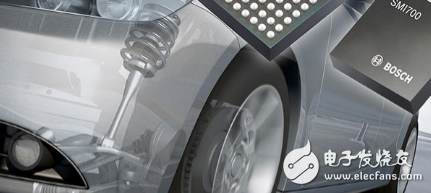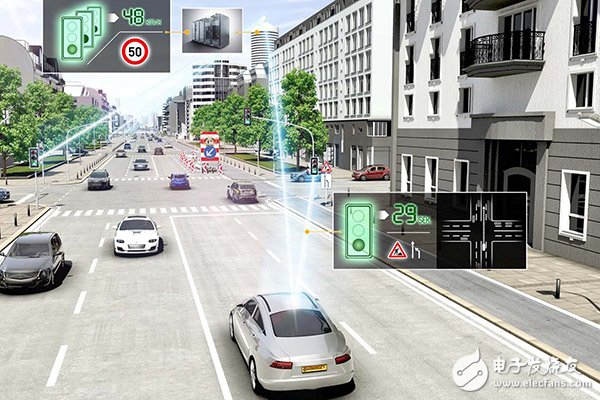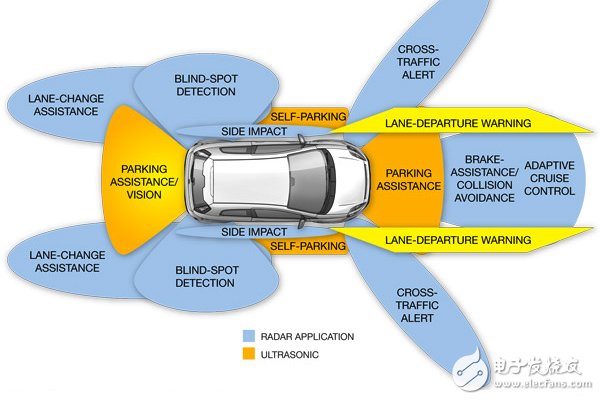As early as twenty years ago, automakers began using accelerometers in MEMS (Micro Electro Mechanical Systems) sensors to measure acceleration during travel and trigger airbags. Today, a forward-looking tiny device, the inertial sensor, opens up a whole new path for accelerometers to be used in a wider range of driver assistance systems.
A variety of MEMS inertial sensors, such as gyroscopes, pressure sensors, and magnetometers, are already included in current driver assistance systems. The gyroscope is capable of monitoring the X-axis rotation of a rollover vehicle – this is also the most important part of the collision monitoring algorithm. In fact, without the anti-rollover safety features of this technology, there will be no SUV models that are popular today.

The importance of inertial sensors for future autonomous driving is undoubted, they can achieve a lot of driver assistance functions, some of which have come to us, some will come soon in the near future.
What do engineers need to know about MEMS inertial sensors when designing a driver assistance system? What do these technologies mean for automakers and consumers in the next ten to twenty years? Let's explore how these different types of tiny sensors will work in current and future automotive technologies.
Rollover sensing is not easyRollover sensing, as a passive safety technology, is primarily used to monitor whether a vehicle has tipped over and triggers an airbag. Such inertial sensors provide the most critical data feedback (rolling angular velocity, lateral and longitudinal acceleration) for collision monitoring algorithms.
However, there will be a difficulty in this process, how to maintain a reliable transmission under various conditions, such as at very low or very high temperatures, on the highway, or on gravel roads. Sense signal. Another active safety technology, the ESC for the body's electronic stability system, avoids body slip by controlling and triggering the brakes, as well as providing reliable sensing signals under different conditions.
One solution to this difficulty is to carefully design a device that combines the design features of MEMS while meeting the needs of automotive systems. The first step is to design the product according to different specifications. The sample must also be tested in the laboratory and meet all the requirements in the document. Finally, the sensor also needs to pass some practical driving tests, such as driving in the cold winter season or on the gravel road.
Can also navigate in the "city canyon"Today's owners are already familiar with the built-in navigation system, which eliminates the hassle of the driver planning his own route in an unfamiliar city. Depending on maps, global navigation satellite systems, and path algorithms and inertial navigation systems, car owners can access real-time road congestion information through interconnected services such as “road congestion assistanceâ€.

Automotive engineers often prefer to incorporate inertial sensors into their navigation systems, because their systems can still operate in cities that are in a row of buildings, or where GNSS signals are weak or even disrupted. . Usually the inertial sensor can still update the position information after acquiring the last reliable satellite signal.
For example, when a driver is driving in a tunnel and the positioning system signal cannot be received, the inertial sensor calculates the direction in which the car is traveling by unit distance. The dead reckoning algorithm calculates the displacement of the vehicle and then estimates the current location of the vehicle based on the signal from the inertial sensor.
Variety of driver assistance systemsThe driver assistance system is not limited to the cruise control or reversing images we are familiar with today. Adaptive cruise, lane keeping and lane change assist, predictive emergency braking (AEBS), and active front steering, all of which are driver assistance systems, and they all rely on inertial sensors and cameras, radar or lidar Intelligent integration of these sensing systems.

Adaptive cruising is more empirically oriented than the traditional fixed-speed cruising that is well known. Although traditional cruise control saves fuel and provides greater comfort for long-distance driving, the driver needs to manually turn the cruise function on or off based on the speed of the surrounding vehicle. Compared to the constant speed during cruise, adaptive cruise can automatically adjust the speed according to actual needs to maintain a safe distance from the surrounding vehicles.
Adaptive cruises measure the distance to an object primarily through radar, cameras, and rays. The same inertial sensor used in the body's electronic stability system can also be used for adaptive cruising. This sensor can help predict the route and communicate it to the obstacle detector.
Another similar inertial device is applied to the ramp assist system to prevent the uphill vehicle from rolling backwards. A small-range gravity acceleration sensor within the device is capable of determining the inclination by measuring gravity.
The Active Steering System is another driver-assisted technique to reduce the amount of change in steering angle each time the steering tire moves. This feature provides a safer and safer driving, especially on the highway. The yaw rate sensor can provide information about the displacement of the vehicle.
Today, some driver assistance systems have been used in some mid-range models, not just luxury models. BMW has introduced the active steering system very early, and Ford has also applied the system to its SUV model, "Sharp", and in the near future, more automakers will follow.
Just like an inertial sensor can be combined with a camera, radar and laser to achieve driver assistance, predictive technology can achieve automatic driving by predicting the displacement of the vehicle.
"Mom looks at me, I have no hands!"
Current autonomous driving combines a range of existing driver assistance features. Fully automated vehicles need to be familiar with the environment around the body and predict the behavior of other vehicles and pedestrians. Predictive technology can predict the vehicle's route on the highway through high-precision maps and vision systems, which is much easier than in urban roads, but the latter will also be realized in the near future. This kind of "deep learning" artificial intelligence technology is essential for future fully automated vehicles.
Positioning and navigationIn fully automatic driving, a car is like a robot, answering various questions, such as: "Where am I?" "Where do I want to go?" and "How do I go there?" The answers to these questions are mainly from the inch level. Precise positioning, they are essential for future autonomous driving and fully automated vehicles. The navigation system we use every day can directly plan the route to the nearest Starbucks. In comparison, the positioning system needs to be more accurate and even accurately locate the lane in which the vehicle is located.
In autonomous vehicles, the positioning function is mainly derived from the technologies applied in the following two fields: robotics and transportation.
Using sensing systems such as cameras, lasers, and radar, robotics researchers have developed a completely new way to determine the relative position between the driver and the object. For example, a robotic car can map the environment around the body and associate its location with these environments based on a real-time location and map system. Using the surrounding landmarks and determining the location of these landmarks on a built-in high-precision map, the location of the vehicle can be obtained accordingly.
The inertial navigation system is capable of determining the change in the absolute position of the vehicle by measuring the acceleration and the angle of rotation. This technique has been fully practiced in the transportation industry. Starting with the initial absolute position (which can be derived from global positioning navigation systems, landmark positioning or real-time positioning and mapping systems), the strapdown algorithm can calculate the changed position based on the inertial sensor readings.
Depending on the accuracy of the positioning, inertial navigation systems sometimes require high-performance sensors to avoid the serious consequences of subtle deviations, such as ring laser gyroscopes and fiber optic spirals to meet the highest requirements. In recent years, high-performance MEMS has successfully entered the strategic planning market.
Fusion of inertial sensors and sensory sensorsHow does the vision and perception system benefit from inertial sensors? The visual or sensory sensor can perceive the moving object, correctly determine the structure of the moving object, and estimate the movement of the vehicle and the distance between the moving object and the surrounding moving object.

Inertial sensors are completely unaffected by the limitations of the sensor, such as weather conditions, lighting, snow, or occluded landmarks. Inertial sensors do not rely on the brightness of the surrounding environment because they measure physical motion and do not calculate data from the image. In addition, inertial sensors are more reliable because they do not require any interconnection and data exchange with devices other than the body. In a recent study, different cooperation modes of kinesthetic inertial sensors and visual perception systems under weak coupling and tight coupling were discussed.
At the weak coupling level, the sensing system and the inertial sensor will each independently position the vehicle, and then compare the information with each other to correct the result. Tight coupling is another result, where direct (pixel-level) visual measurements of the object are combined with the readings of the inertial measurement device.
In both cases, the MEMS inertial sensor can improve the compatibility of the sensing system frame-to-frame tracking object for more accurate positioning.
Where is the future?On the road to the evolution of autonomous driving functions, driver assistance systems, such as lane keeping and lane change assist, predictive emergency braking systems, and active front wheel steering systems, will become more and more familiar. Some autopilot functions, such as the traffic congestion aid system, are currently available and will be gradually expanded in the coming years. The advanced autopilot feature will follow.
By 2020, we expect to be fully automated on the highway. Automated driving in the city is expected to take ten to fifteen years to complete.
With such a wealth of technology available, it is believed that automakers will continue to meet consumer demand for driver assistance systems until fully automated or partially autopilot functions benefit most consumers. Although fully automated driving will take time to fully realize, MEMS and a range of driver-assisted systems created by sensors have brought many benefits to our lives.
The FirstPower High temperature battery is desgined for apllcation as extreme temperatures version. This series is specifically for application where robust battery performance is required to withstand harsh temperature environment.
We welcome orders with "FirstPower" brand; We are also flexible to accept orders on OEM basis. Contact us now! Your partnership with FirstPower will prove worthy of it.
High Temperature Battery,High Temperature Solar Battery,High Temperature Gel Battery,High Temperature Long Life Battery
Firstpower Tech. Co., Ltd. , https://www.firstpowersales.com
